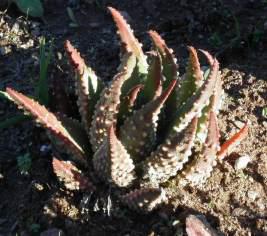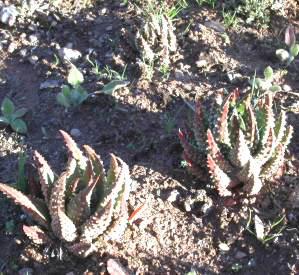Tulista pumila
Tulista pumila (L.) G.D.Rowley (=Haworthia maxima (Haw.) Duval, Haworthia pumila (L.) Duval)
Family: Asphodelaceae
Common names: miniature aloe, pearl plant (Eng.); vratjiesaalwyn, kleinaalwyn, seepaalwyn (Afr.)
Introduction
This water-wise, small aloe-like plant with warty white tubercles on the leaves makes a very interesting coffee table plant. It was previously known as Haworthia maxima.

Description
Description
The plant is a succulent that looks like a miniature aloe. It grows in a compact rosette, is more or less stemless, and approx. 250 mm tall. Leaves are 140 x 20 mm. What makes this plant interesting are the raised , more or less rounded, greenish white tubercles that are very conspicuous on the underside of the leaf surface. The flower spike is approx. 400 mm tall. The aloe-like flowers are brownish-white and waxy in texture. Flowering time is early summer (October-November). Seed ripens in February-March of the following year.

Conservation Status
Status
Least Concern (LC). Tulista pumila has a relatively small natural range, but is not endangered.
Distribution and habitat
Distribution description
The plant occurs in Karroid Broken Veld and is common in the Worcester-Robertson Karoo, particularly around Worcester, Robertson, Ashton, Bonnievale, Montagu and Drew.
The plant occurs in a winter rainfall area of Western Cape, whichexperiences mild frost, -2°C. Summers are hot, up to 44°C. Rainfall varies from 150 mm (Worcester area) to 350 mm (Montagu area).
Derivation of name and historical aspects
History
The plant was widely known Haworthia margaritifera and H.pumila, became Haworthia maxima for a while then became Haworthia pumila and is now Tulista pumila. The nomenclature is complicated, see Mottram 2000 for details of earlier name changes.
Ecology
Ecology
Pollinators include bees, moths, bumble bees, the Malachite and the Lesser Doubled-collared Sunbirds.
Uses
Use
The leaves of the plant are mashed and used by traditional healers as soap. The leaves crushed and broken up can also be used as a poultice. Fears that it is being over-collected in the wild are emerging. Horticultural uses include planting in rock gardens and they also make wonderful miniature succulent pot displays. In larger gardens they can be used with great effectiveness as mass plantings in a bed.
Growing Tulista pumila
Grow
Propagating from fresh seed is easy. Seed older than18 months in most cases is not viable, unless kept under cool, dry conditions. Seed is similar to those of aloes, but much smaller.
Sow the seeds in autumn (April), which is when the first rain normally falls in the winter rainfall Karoo. Sow in well-drained, rich, loamy soil. Sow no deeper than 30 mm. Water enough to keep the soil merely damp, and ensure the growing medium is not soggy. A very wet growing medium will cause damping-off of the seedlings or result in the seeds rotting.
Viable seed should germinate with 21 days. Once the seedlings are strong enough, after about one year, transplant into containers. Initially keep strong sunlight off the young plants. Once the plants have adapted to stronger light they can be planted out in the open.
The plants live for about 30 to 40 years if they are looked after properly. It grows relatively slowly from seed and it takes about 5 years for a plant to reach flowering maturity.
Pests include mealie bug, aphids and red spider mite. Aphids canbe controlled by spraying with washing-up liquid soap. A mix of10 ml liquid soap to 1 litre water is recommended. Mealie bug, can be effectively controlled by spraying with a mixture of methylated spirits and water. A mix of 10 ml to 1 litre water is recommended.Red spider mite is not so easy to eradicate, use recommended miticides for this purpose.
Plants can be fed with 2:3:2, bone meal and seaweed extracts.
References
- Germishuizen, G., Meyer, N.L., Steenkamp, Y. & Keith, M. (eds) 2006. A Checklist of South African plants. Southern African Botanical Diversity Network Report No. 41. SABONET, Pretoria.
- Bayer, M.B. 1999. Haworthia revisited. A revision of the genus. Umdaus Press, Pretoria.
- Bayer, M.B and van Jaarsveld, E. 2001. Haworthia. in Illustrated Handbook of Succulent Plants: Monocotyledons. Springer, Berlin.
- Mottram, R. 2000. Haworthia pumila, margaritifera, or what? Haworthiad Vol.14(1)22-24pp.
Credits
Ian Oliver
Karoo Desert National Botanical Garden
July 2003
Plant Attributes:
Plant Type: Succulent
SA Distribution: Western Cape
Soil type: Sandy, Loam
Flowering season: Early Summer
PH: Acid, Neutral
Flower colour: Brown, White
Aspect: Full Sun, Morning Sun (Semi Shade), Afternoon Sun (Semi Shade)
Gardening skill: Average
Special Features:
Horticultural zones







Rate this article
Article well written and informative
Rate this plant
Is this an interesting plant?
Login to add your Comment
Back to topNot registered yet? Click here to register.